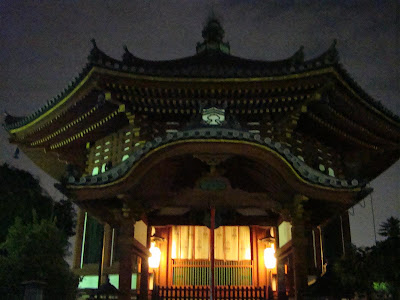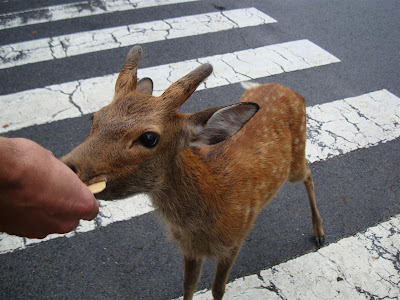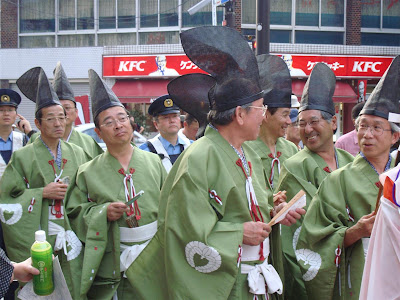 -
--
-
-
-
-
-
-
-
-
-
-
-
-
-
-
-
-
-
-
-
-
-
-
We spent the weekend of September 12-14 in Nara, the 8th century capital of Japan. After about two and a half hours on five different trains, we arrived on Friday evening. We checked in at Ryokan Hakuho (a ryokan is a traditional Japanese-style inn) and went out for a tasty dinner of Chinese food.
-
 -
--
After dinner we took a stroll over to Kofukuji. Walking the temple grounds at night was quite pleasant, as there were only a few other people there.
-
 -
--
The hall that houses the Kannon image, above.
-
 -
--
-
-
-
-
-
-
-
-
-
-
-
-
-
-
-
-
-
-
-
-
-
-
One of two pagodas at Kofukuji, this one dates from 1143.
-
 -
--
We headed out on Saturday after a brief rainstorm, which cooled the temperatures down but made the morning quite humid. Near the station this sign is posted- in 475 days Nara will celebrate the 1,300th year of its founding as capitol of Japan. I love the mascot- a combination of the Daibutsu (Great Buddha) and the deer that roam Nara. Awesome.
-
 -
--
As we walked over to Todaiji we were met by the famous Nara deer, of which about 1,200 roam freely in town.
-

-
-
-
-
-
-
-
-
-
-
-
-
-
-
-
-
-
-
-
-
-
-
-
For 150 Yen we bought deer crackers. This is a sure way to get the attention of the deer.
-
 -
--
For the most part, the deer are gentle, however longtime readers of this blog know of my experience 2 years ago in Nara when I was bitten on the behind by a particularly hungry deer. Nothing of the sort happened to us this time. One deer did try to eat Joe's t-shirt, and another was interested in my coffee, but they were pretty harmless and quite cute.
-
 -
--
After the novelty of feeding and petting the deer wore off we made it over to Todaiji.
-
 -
--
This particular deer was posing with the tourists at the World Heritage sign. Hilarious...
-
 -
--
The Nandaimon (Great South Gate) is the first structure that you walk through. The tiny size of the people in the image give an idea of scale.
-

-
-
Deer posing with a view towards the main hall of Todaiji.
-

-
-
-
-
-
-
-
-
-
-
-
-
-
-
-
-
-
-
-
-
-
-
-
Inside the Nandaimon are two huge wood sculptures of Nio (guardians) dating from the 13th century sculpted from multiple blocks by the Kei school of artists.
-

-
-
-
-
-
-
-
-
-
-
-
-
-
-
-
-
-
-
-
-
-
-
-
-
Me doing my best Nio action pose.
-
 -
--
-
-
-
-
-
-
-
-
-
-
-
-
-
-
-
-
-
-
-
-
-
-
After a bit of walking we arrived at the Daibutsuden (Great Buddha Hall), which is the largest wooden building in the world. The current structure dates from the 18th century, and amazingly the earlier versions of the building (destroyed by fires and wars) is about 2/3rds the size of the original built 1,000 years earlier.
-
 -
--
-
-
-
-
-
-
-
-
-
-
-
-
-
-
-
-
-
-
-
-
-
-
Joe and I in front of the Daibutsuden.
-

-
-
Inside of the hall is a huge bronze Daibutsu (Great Buddha) sculpture. The sculpture is over 45 feet tall and represents Dainichi, the Cosmic Buddha.
-
 -
--
-
-
-
-
-
-
-
-
-
-
-
-
-
-
-
-
-
-
-
-
-
-
While the current bronze Daibutsu dates from the Edo period (1600-1868), the pedals seen below are a remnant of the base of the original Nara period (710-794) sculpture.
-
 -
--
Me imitating the mudra (hand gesture) of Dainichi.
-
 -
--
-
-
-
-
-
-
-
-
-
-
-
-
-
-
-
-
-
-
-
-
-
-
Koumokuten, one of the four guardian kings.
-
 -
--
-
-
-
-
-
-
-
-
-
-
-
-
-
-
-
-
-
-
-
-
-
-
At the back of the temple one of the support pillars has a hole carved in it. According to popular belief this hole is the same size as the nostril of the Daibutsu, and crawling through it will guarantee enlightenment. In practice this is a pretty amusing display of little kids crawling through and their parents taking photos.
-
 -
--
Bishamonten, another of the four guardian kings.
-
 -
--
-
-
-
-
-
-
-
-
-
-
-
-
-
-
-
-
-
-
-
-
-
-
Daibutsu and attendant bodhisattva.
-
 -
--
We bought some souveniers on our way out of the temple. For Joe, a Rirakuma charm (the little bear) wearing deer antlers and chowing on deer crackers. It adorns his electronic dictionary.
-
 -
--
For me, it was Hello Kitty chillin' in the arms of the Daibutsu. This charm now hangs from my cellphone.
-
 -
--
Our next stop was lunch- cold soba and tempura for Joe, warm soba for me.
-
 -
--
-
-
-
-
-
-
-
-
-
-
-
-
-
-
-
-
-
-
-
-
-
-
After resting our feet and cooling off at lunch we spent the afternoon at the Nara National Museum visiting the phenomenal temporary exhibition on the 33 Kannon Pilgramige Sites of Western Japan. This show brought together an amazing array of Buddhist sculpture and painting dating from as far back as the 7th century. I think my look says, "Shall we go?"
-
 -
--
As expected no photography was allowed in the museum. When we ventured back out into the world after hours of art viewing the afternoon was cooling off. Below is the new wing of the Nara National Museum.
-
 -
--
And here is the original structure, dating from the Meiji period (1868-1912).
-
 -
--
This is my very happy museum-going expression. I'm loopy after seeing so much fabulous art.
-
 -
--
As we walked back to our ryokan we passed again through Kofukuji, this time enjoying it in daylight.
-
 -
--
-
-
-
-
-
-
-
-
-
-
-
-
-
-
-
-
-
-
-
-
-
-
Kofukuji.
-
 -
--
Sunset at Kofukuji.
-
 -
--
The five story pagoda at Kofukuji, dating from 1426.
-
 -
--
We spent some time browsing on the shopping street near the station before heading to dinner.
-
 -
--
-
-
-
-
-
-
-
-
-
-
-
-
-
-
-
-
-
-
-
-
-
-
We bought some fancy artisan chocolates to enjoy for dessert.
-
 -
--
We had a tasty Italian dinner at Mellow Cafe, Joe had the Tuna Spaghetti, I had the Pesto. Yum.
-
 -
--
-
-
-
-
-
-
-
-
-
-
-
-
-
-
-
-
-
-
-
-
-
-
Our fancy chocolate, which we enjoyed back a the ryokan. It was slightly bitter chocolate coated in green tea powder. Mmmmm......
-

-
-
In the evening we enjoyed the steaming public bath at the ryokan, a relaxing part of the Japanese inn experience.
-
 -
--
We started off on Sunday by taking the train south of town and then a bus over to Horyuji.
-
 -
--
Horyuji, founded in 607, is the oldest surviving Buddhist temple in Japan. This is one of my favorite places in the world to visit. The wooden buildings are some of the oldest in the world, and the Treasure House contains some amazing works of art.
-

-
-
Rooftiles as we entered the temple grounds.
-
 -
--
The temple gate.
-
 -
--
Joe doing his best Nio pose, DJ Nio.
-
 -
--
I love World Heritage!
-
 -
--
-
-
-
-
-
-
-
-
-
-
-
-
-
-
-
-
-
-
-
-
-
-
The pagoda at Horyuji. I love the natural, earthy feel of the temple grounds and buildings. The pagoda at Horyuji has beautiful dimensions and the interior houses 4 tableau of scenes from the Buddha's life that date from the 8th century.
-
 -
--
-
-
-
-
-
-
--
-
-
-
-
-
-
-
-
-
-
-
-
-
-
-
Looking up at the pagoda roofline.
-
 -
--
-
-
-
-
-
-
-
-
-
-
-
-
-
-
-
-
-
-
-
-
-
-
The gate from the inside. Unfortunately, the kondo (main hall) was being repaired, so we couldn't go inside and there was scaffolding on the exterior. Thankfully the sculptures that are usually housed in the kondo (including the bronze Shaka triad from 623) were on exhibit elsewhere.
-
 -
--
Scenes from the Horyuji grounds.
-
 -
--
 -
--
-
-
-
-
-
-
-
-
-
-
-
-
-
-
-
-
-
-
-
-
-
-
 -
--
 -
--
The above photo is the Treasure House.
-
 -
--
Lotus pond.
-
 -
--
 -
--
-
-
 -
--
 -
--
 -
--
Leaving the temple grounds in the bright sun.
-
 -
--
-
-
-
-
-
-
-
-
-
-
-
-
-
-
-
--
-
-
-
-
-
The shopping street leading up to Horyuji.
-
 -
--
We walked a few blocks to the bus station where we waited for about half an hour in the heat.
-
 -
--
The bus that took us to Yakushiji.
-
 -
--
-
-
-
-
-
-
-
-
-
-
-
-
-
-
-
-
-
-
-
-
-
-
More World Heritage!
-
 -
--
Yakushiji was founded in 680, but the buildings are reconstructions from later dates. The main hall (above) was built in the 1970s.
-
 -
--
-
-
-
-
-
-
-
-
-
-
-
-
-
-
-
-
-
-
-
-
-
-
Another Nio!
-
 -
--
-
-
-
-
-
-
-
-
-
-
-
-
-
-
-
-
-
-
-
-
-
-
This pagoda dates from 730, and although it looks like it has 6 floors, it actually has 3 with 3 lean-to structures.
-
 -
--
The Yakushi (Medicine Buddha) triad housed in the main hall.
-
 -
--

-
-
 -
--
-
-
-
-
-
-
-
-
-
-
-
-
-
-
-
-
-
-
-
-
-
-
 -
--
 -
--
The Shinto Shrine located next to Yakushiji.
-
 -
--
-
-
Sake barrels outside of the shrine.
-
 -
--
Lanterns near the bus stop.
-
 -
--
As we stepped off the bus near Nara Station we were pleased to come across a procession leading to a festival celebrating the autumn full moon.
-
 -
--
Looking up the street at the crowd.
-
 -
--
The parade begins!
-
 -
--
-
-
-
-
-
-
-
-
-
-
-
-
-
-
-
-
-
-
-
-
-
-
-

-
-
-
-
-
-
-
-
-
-
-
-
-
-
-
-
-
-
-
-
-
-
-
 -
--
After watching the procession we stopped into a shop to purchase some brushes and an ink stone with which to practice kanji.
-
 -
--
The parade slowly made it through town to a small lake where men in boats lit lanterns. We didn't stick around for too much of the festivities, as it was getting late.
-
 -
--
For dinner we enjoyed Vietnamese food at a small restaurant near the station before heading home.
-
 -
--
-
-
-
-
-
-
-
-
-
-
-
-
-
-
-
-
-
-
-
-
-
-

No comments:
Post a Comment